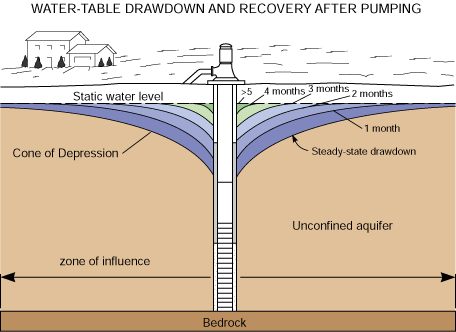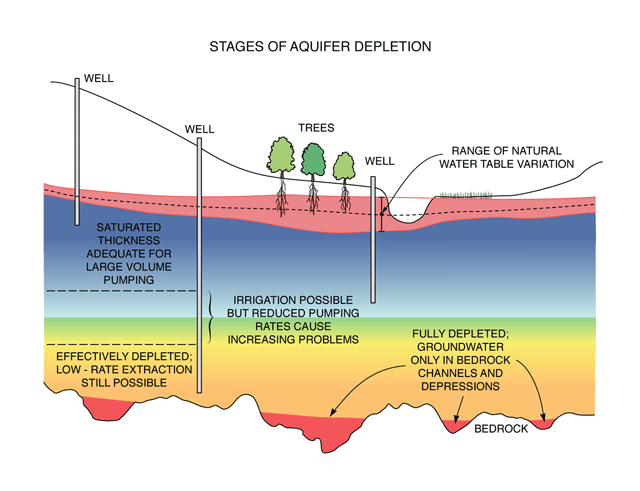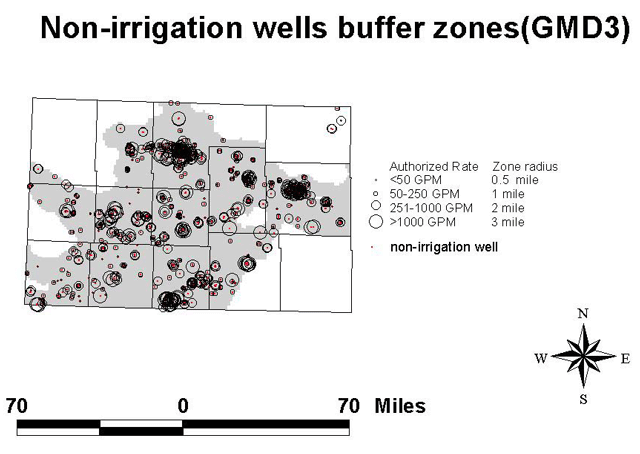
R. W. Buddemeier
Boldface links are to other atlas sections; italic items are linked to glossary definitions
Withdrawal of a thousand gallons per minute (a common pumping rate for high volume wells) is an unnaturally rapid change in a groundwater system (see appendix on groundwater storage and flow), and results in some major perturbations of the water table. Initially, water level drops very rapidly in the immediate vicinity of the well. This lowering of the water table is known as drawdown, and may amount to many tens of feet (see figure 1 below). This is why thinly saturated zones are unsuitable for high volume pumping even if substantial water is present -- the saturated thickness must be large enough so that the pump can remain completely submerged at maximum drawdown.

Figure1. Illustration of drawdown and recovery terms and processes. The figure is not to scale, and is intended to represent the basic concepts, not the relative or absolute magnitudes. Drawdown near the well can be a number of tens of feet, and the zone of influence can greater than a mile.
In areas where the water table is declining, the aquifer may become progressively less useful for various types of withdrawals as the water level decreases to and past the elevation at which high-rate drawdowns would be in excess of the available saturated thickness. Figure 2 (below) illustrates this, and the extended caption further defines and discusses some of the issues that suggest a possible need for definition of a sustainability reserve--the amount of water in storage that would be required for effective long-term management and reliable use whatever amount is determined to be sustainable for a given aquifer subunit. This would be the amount of water in storage that would trigger mandatory use reductions if a transition plan is not already in effect. Management subunits can be defined on the basis of surface and bedrock topography, alluvial channels, aquifer characteristics, and the present distribution of various types of water use; such considerations effectively determine both transition strategies and long-term management principles.

Figure 2: Resource use zones and progressive aquifer
exhaustion.
As pumping continues, the rate of local drawdown decreases and eventually stabilizes as the withdrawal is compensated for by inflow of groundwater from the surrounding area. As this happens, the measurable decline in the water table spreads outward. When the groundwater system has adjusted to the pumping, the resulting pattern of water table depression is sometimes referred to as steady-state drawdown; this feature is illustrated in figure 1. The pattern of water table distortion is called the cone of depression, and the area over which the depression can be detected is called the zone of influence of the well. This zone of influence can easily have dimensions of a mile or more, depending on the characteristics of the aquifer. Figure 3 illustrates the estimated distribution of zones of influence of non-irrigation wells in GMD3. This map, in combination with the depletion and reduction maps, can also provide an indication of the potential needs and priorities for management subunits and the designation of sustainability reserves for the transistion from non-sustainable irrigation to sustainable non-irrigation uses.

Figure 3: Estimated zones of influence of non-irrigation
pumping wells in Groundwater Management District Number 3.
When pumping ceases, lateral inflow continues, and the water table gradually recovers toward an equilibrium value. This recovery is fastest where the depression is greatest and slows as equilibrium is approached. Figure 1 indicates some aspects of the recovery process -- in particular the fact that it may take months for full recovery to occur.
This rapid distortion and slow recovery is one of the major complications involved in making accurate estimates of water table (and therefore saturated thickness and volume of water) changes over time. Even though water levels are measured annually in the winter when irrigation pumping has been at a minimum for some months, it is probable that full recovery of the water table never occurs, and some pumping does occur outside of the normal spring-summer growing season. For example, municipal supply wells, well maintentance and testing, 'pre-irrigation' pumping, and irrigated winter wheat production may all affect water-table conditions close to the winter measurement period. A water-level measurement made near a recently pumped well may be significantly affected, which is one of the reasons why water-level change estimates (see the Estimated Usable Lifetime section, and the appendix on water-level decline rates) are constructed from multi-year averages. Highly accurate, short-term measurements of change in a large, variable system are extremely difficult to obtain.
Irrigation pumping is the major aquifer stress and the most demanding application, since as normally practiced it requires high single-well withdrawal rates to extract large volumes of water over a limited period of time. This in turn creates large local drawdowns (cones of depression), which therefore require a certain minimum saturate thickness for the pumps to function effectively. Municipal, industrial, or other relatively large-volume uses are not as demanding, because they are intermittent and/or spread more uniformly throughout the year.
As a first approximation, 30' has been used as an effective limit to high-rate irrigation pumping (the actual limiting thickness will vary with local conditions). For an irrigated area, this is effective depletion.
Full depletion is achieved when there is a significant probability that a well drilled to bedrock in a given are will not encounter usable water.
Recharge rates in most of the High Plains aquifer are such that domestic, municipal, and infrastructure (power generation, construction, etc.) needs can be sustainably supported if there is adequate water in storage to manage variations in demand and recharge.
If a region makes an effective transition to dryland farming (or some other low-water-use economic base) at or before the time of effective depletion, water reserves should be roughly adequate to sustain other activities. If, however, higher efficiency water extraction techniques (multiple-well manifolds, improved irrigation efficiency, etc.) further deplete the aquifer, large areas may become unable to sustain basic economic activity as full depletion is approached. It has been suggested that the water necessary for basic life support and community function might be considered a public trust, to be sustainably managed for the future.
Back to Directory
Funded (in part) by the Kansas Water Plan Fund